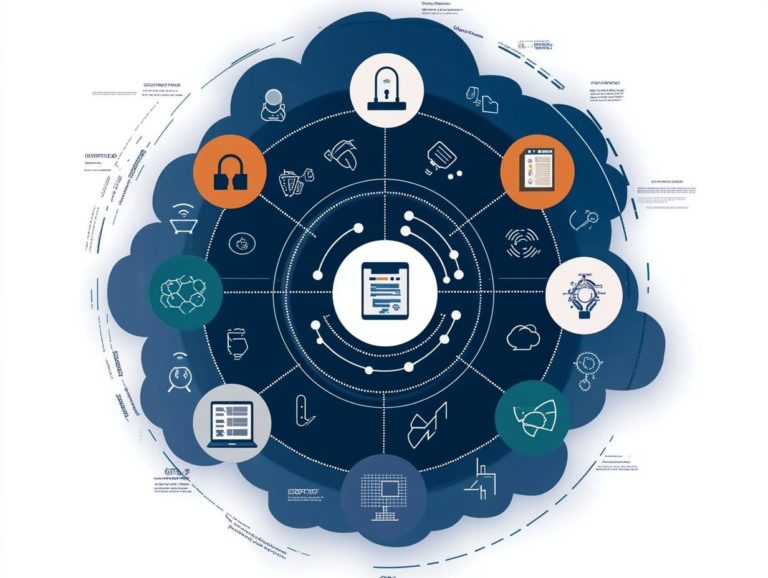How to Build a Cloud Security Culture
In today s digital landscape, embracing cloud computing brings remarkable advantages, yet it also presents significant security challenges.
For your organization, establishing a strong cloud security culture is vital to safeguarding sensitive information. This exploration delves into the essential elements of a dynamic security culture, from recognizing the inherent risks associated with cloud technology to implementing effective training programs for your employees.
You ll find insights on the significance of security policies, selecting the right tools, and fostering collaboration with cloud service providers, all designed to equip your organization to adeptly navigate the complexities of cloud security.
Join in as you uncover key strategies to create a resilient security environment that not only protects your data but also empowers your workforce.
Contents
- Key Takeaways:
- The Importance of Cloud Security Culture
- Creating a Culture of Security Awareness
- Implementing Security Policies and Procedures
- Utilizing Cloud Security Tools
- Building a Strong Security Team
- Continuous Monitoring and Improvement
- Collaborating with Cloud Service Providers
- Frequently Asked Questions
- What is a cloud security culture?
- Why is it important to build a cloud security culture?
- How to Build a Cloud Security Culture
- What are some common challenges when building a cloud security culture?
- How can I ensure that my cloud security culture is effective?
- Can a strong cloud security culture prevent all cyber attacks?
Key Takeaways:

The Importance of Cloud Security Culture
In today’s digital landscape, building a strong cloud security culture is essential for your organization aiming to protect sensitive data and maintain digital trust. For effective protection, it’s crucial to follow cloud security best practices. A strong security culture means more than just policies; it involves everyone actively participating.
Your leadership’s commitment is crucial. It drives the organizational culture to prioritize security, helping to mitigate cyber threats like data breaches and ensuring compliance with critical standards such as GDPR and HIPAA.
A well-integrated security culture enhances how you respond to incidents and aligns security initiatives with your overall business objectives, cultivating resilience against ever-evolving security challenges.
Understanding the Risks of Cloud Computing
Cloud computing offers a wealth of benefits, but it also presents a range of risks that you must comprehend to effectively safeguard your assets. These risks include unauthorized access, data loss, and compliance violations each with significant implications for your business’s continuity and reputation.
To address these vulnerabilities, conduct regular risk assessments tailored to identify potential threats specific to your cloud architecture. By adopting a systematic approach to vulnerability management, including continuous monitoring and timely software patching, you can significantly reduce the likelihood of attacks.
Strengthening your defenses with multi-factor authentication, which adds an extra step to verify your identity before accessing data, and encryption will provide an additional layer of security.
Ultimately, you must craft a resilient security strategy now to stay ahead of emerging threats!
Creating a Culture of Security Awareness
Establishing a culture of security awareness within your organization is crucial for empowering employees to take ownership of their security responsibilities and actively participate in safeguarding your assets.
This culture flourishes through comprehensive security training programs that highlight the significance of recognizing cyber threats and implementing security best practices in everyday operations.
By fostering an environment of continuous security education and nurturing security champions within teams, you can enhance employee engagement and ensure that effective communication strategies promote security awareness at all levels.
Training and Education for Employees
Effective security training and education programs are essential for equipping you with the knowledge and skills necessary to recognize and respond to potential threats like phishing and malware attacks. These programs should help you understand secure development practices while emphasizing your accountability in maintaining a secure environment.
Regular updates and interactive sessions can significantly boost your engagement and retention of key security concepts. Don’t wait! Start your security training now to protect your organization.
By engaging in hands-on learning experiences, you ll have the chance to practice your skills in a safe environment, building confidence in your abilities. Incorporating real-world scenarios into the curriculum illustrates the consequences of security breaches and makes the material more relatable.
Ongoing education is crucial. Frequent refresher courses not only reinforce what you ve learned but also introduce you to new threats and trends, ensuring you stay vigilant and informed in an ever-evolving digital landscape.
Implementing Security Policies and Procedures

Implementing robust security policies and procedures is essential for creating a safe space that meets compliance standards and bolsters effective security governance.
These policies should lay out clear guidelines for incident response, risk management, and employee conduct, ensuring that every stakeholder comprehends their roles and responsibilities in protecting sensitive information.
Integrating security frameworks like ISO 27001, a standard for managing information security, and PCI DSS helps you adopt a comprehensive approach to managing security risks and elevating your overall security posture.
Establishing Clear Guidelines for Cloud Usage
Establishing clear guidelines for cloud usage is crucial to ensure that every employee understands their responsibilities and the key elements of a cloud security strategy necessary to protect their organization’s data.
These guidelines must be communicated effectively and backed by comprehensive security policies that outline acceptable use, access controls, and protocols for responding to potential incidents. By fostering a culture of responsibility and employing continuous communication strategies, you can significantly reduce risks associated with cloud computing, including understanding how to ensure compliance in cloud security.
In addition to clear communication, your guidelines should incorporate robust data protection measures, such as encryption protocols and regular backups to safeguard information against breaches.
Access management protocols are equally vital, ensuring that only authorized personnel can access sensitive information.
Conducting regular training sessions can further enhance employee awareness and reinforce best practices related to cloud security risk assessment.
Keeping your guidelines updated is essential to adapt to evolving threats and technologies, necessitating periodic reviews and adjustments to the policies.
This proactive approach not only minimizes vulnerabilities but also builds a resilient framework that supports your organization’s growth while maintaining data integrity.
Utilizing Cloud Security Tools
Utilizing cloud security tools effectively is essential for any organization looking to strengthen its defenses against ever-evolving security challenges while maximizing its security investments.
These tools encompass advanced mechanisms such as threat detection systems, encryption technologies, and access management solutions, all of which work in harmony to elevate your overall security posture.
By systematically monitoring their effectiveness, you can refine your strategies and ensure resilience against emerging cyber threats.
Stay ahead of threats. Invest in your training today!
Types of Tools and Their Benefits
There are many cloud security tools available. Each tool tackles specific security aspects like threat detection, encryption, and access management.
These tools help you manage vulnerabilities and protect sensitive data stored in the cloud. Understanding each tool’s benefits allows you to tailor your security strategies effectively.
You can categorize these tools by their functions. This helps pinpoint solutions that match your needs.
Threat detection tools use advanced algorithms and machine learning to catch potential breaches early. This significantly reduces risk.
Encryption solutions protect sensitive data during transit and storage. They keep unauthorized parties away.
Access management tools improve governance by facilitating secure user authentication and authorization protocols.
Consider case studies from healthcare organizations that use encryption to protect patient data. These examples show how cloud security tools can mitigate risks while ensuring compliance with regulations.
Building a Strong Security Team
Building a robust security team is crucial. It helps your organization tackle today s complex cyber threats effectively.
A well-structured team features clearly defined roles. Each member can leverage their unique skills.
Include security champions who drive engagement. They cultivate a culture of security awareness across departments.
Aligning security initiatives with your goals enhances incident response capabilities. It also strengthens resilience strategies.
Roles and Responsibilities in Cloud Security

In cloud security, clearly defining roles and responsibilities is essential. This ensures effective management and governance of security practices.
Each team member, from the Chief Information Security Officer (CISO) to security analysts, plays a key role in responding to security issues. They also maintain compliance with established frameworks.
The CISO oversees the entire security strategy. This role ensures risk management aligns with business objectives.
Cloud engineers focus on creating secure systems. Security analysts monitor threats and analyze incidents for timely responses.
Collaboration among these roles is crucial. Regular meetings and integrated communication tools foster teamwork and accountability.
Implementing frameworks like the NIST Cybersecurity Framework unifies efforts. It clearly defines roles, ensuring everyone understands their part in cloud security.
Continuous Monitoring and Improvement
Continuous monitoring and improvement are crucial for maintaining an adaptive security posture. This is necessary in today s fast-changing threat landscape.
Regular security audits and risk assessments identify vulnerabilities. They guide necessary improvements for your security framework.
By following best practices and compliance standards, you cultivate a proactive security approach. This significantly enhances your resilience strategies.
Importance of Regular Assessments and Updates
Regular assessments are essential to ensure that your security measures remain effective and comply with standards. By proactively managing vulnerabilities, you can fortify your organization against potential threats.
Security audits and assessments empower you to identify weaknesses in your security and adjust your strategies as needed. This underscores the importance of continuous improvement in your security practices.
Staying vigilant not only shields you from emerging threats but also bolsters your organizational resilience. Conducting a variety of assessments such as penetration testing, vulnerability scans, and risk assessments is vital for a comprehensive security framework.
Aim to perform these evaluations at least annually or more frequently in rapidly changing environments. This allows you to swiftly adapt to new threats.
Regular assessments help identify specific vulnerabilities and foster a culture of security awareness among your employees. Incorporating your findings into a well-defined action plan significantly strengthens your defense mechanisms.
Ultimately, this enhances your overall security and ensures compliance with industry regulations.
Collaborating with Cloud Service Providers
Collaborating effectively with cloud service providers is vital to ensure that your security governance aligns with the security policies and compliance standards upheld by these partners.
This partnership cultivates digital trust and elevates your risk management strategies. It enables you to share security responsibilities while leveraging the expertise of your providers.
By establishing clear communication and setting expectations with cloud service providers, you can mitigate risks and adopt a comprehensive approach to cloud security.
Ensuring Security in Partnership
Ensuring security in partnership with cloud service providers demands a thorough understanding of the security policies and compliance standards that govern your collaboration.
Conduct regular risk assessments and align your security initiatives with those of your providers to create a cohesive approach to security. This joint effort enhances the overall resilience of both parties.
By implementing joint security assessments, you can pinpoint vulnerabilities early on and address them before they escalate into major issues. Establishing aligned compliance measures ensures that both you and your cloud provider operate under the same regulatory frameworks.
Transparency is crucial in these partnerships; it facilitates open communication regarding security responsibilities and potential risks. Fostering accountability means each party takes ownership of their security duties, significantly reducing the likelihood of breaches.
Ultimately, a commitment to shared security protocols protects sensitive data and strengthens the trust between your organization and your cloud service providers.
Frequently Asked Questions

What is a cloud security culture?
A cloud security culture refers to the mindset, practices, and behaviors of individuals and organizations in protecting sensitive data and assets in the cloud. It involves understanding potential risks, implementing security measures, and reinforcing how to ensure cloud security within the organization.
Why is it important to build a cloud security culture?
With the increasing use of cloud technology, it is crucial for organizations to prioritize security. Building a cloud security culture creates a strong defense against cyber threats, minimizes data breaches, and protects sensitive information. To enhance these efforts, learning how to implement cloud security best practices ensures compliance with regulations and builds trust with customers.
How to Build a Cloud Security Culture
The first step is to educate yourself and your team about cloud security best practices. This includes understanding the shared responsibility model, implementing access controls, and regularly updating security protocols. For a comprehensive approach, learn how to conduct a cloud security assessment. Communicate the importance of security and encourage open discussions about potential risks and solutions.
Start today to protect your organization!
What are some common challenges when building a cloud security culture?
Common challenges include resistance to change, lack of awareness, and budget constraints.
Maintaining a consistent security culture can be tough, especially with remote teams or third-party vendors.
Proper planning can help. Continuous reinforcement is key to overcoming these challenges.
How can I ensure that my cloud security culture is effective?
Regularly assess and update your security rules and procedures to keep up with evolving threats and technologies.
Provide ongoing training and support. Encourage a culture of accountability where everyone is responsible for maintaining a secure environment.
Staying informed about the latest security trends and best practices is crucial.
Can a strong cloud security culture prevent all cyber attacks?
A strong cloud security culture goes a long way in lowering the risk of cyber attacks!
Cyber criminals are continually finding new ways to exploit vulnerabilities.
A strong security culture can minimize the impact of an attack and aid quick recovery.






